Second Warning Letter
[Your Name]
[Your Address]
[City, State, Zip Code]
[Email Address]
[Phone Number]
[Today's Date]
[Employee's Name]
[Employee's Position]
[Company Name]
[Company Address]
[City, State, Zip Code]
Subject: Second Warning Letter
Dear [Employee's Name],
I hope this letter finds you well. I am writing to address a matter of serious concern regarding your performance and conduct at [Company Name]. This is the second warning letter you are receiving, as a follow-up to our previous communication dated [Date of First Warning Letter].
As outlined in our initial warning letter, we brought specific issues to your attention regarding [briefly mention the issues discussed in the first warning letter, e.g., poor job performance, repeated tardiness, failure to meet deadlines, etc.]. Unfortunately, since the issuance of the first warning letter, we have observed little to no improvement in these areas.
As an employee of [Company Name], it is crucial that you adhere to company policies, meet performance expectations, and maintain a professional attitude at all times. Your performance directly impacts the overall success of our organization, and we expect every team member to contribute their best effort.
Despite our previous efforts to support you in overcoming the challenges, we have not witnessed a significant improvement in your performance. The following areas continue to be of concern:
1. [Specify the first ongoing performance or conduct issue]
2. [Specify the second ongoing performance or conduct issue]
3. [Specify any additional ongoing performance or conduct issues]
Furthermore, on [date of recent incident], we became aware of [describe the most recent incident, if applicable]. This incident is particularly troubling as it demonstrates a lack of professionalism and adherence to company values.
As a result of your continued underperformance and conduct issues, we are left with no choice but to escalate the disciplinary action. Therefore, effective immediately, the following measures will be implemented:
1. [Specify the consequences, e.g., additional training, increased supervision, etc.]
2. [Any other appropriate measures]
Please be advised that this warning places your continued employment at [Company Name] in jeopardy. We strongly urge you to take this matter seriously and use this opportunity to rectify your performance and conduct.
To support you in your improvement, we are willing to offer the following resources:
1. [Specify any additional training or resources provided]
2. [Any other support offered]
We expect to see immediate and sustained improvement in your performance and conduct. It is essential that you take this warning as a final opportunity to rectify the situation.
You are required to acknowledge receipt of this letter by signing and returning a copy to the Human Resources department by [deadline for acknowledgment, typically within a few days]. If you wish to discuss any concerns or have questions about this letter, please contact your supervisor or the HR department at [HR contact details].
Please understand that we value all our employees and are committed to creating a positive work environment for everyone. However, continued failure to meet performance expectations and uphold our company's values will result in further disciplinary action, which may include termination of employment.
We sincerely hope that you will seize this opportunity to improve and strive to meet the company's expectations. We are willing to work with you to help you succeed in your role, but ultimately, the responsibility for improvement lies with you.
Sincerely,
[Your Name]
[Your Title]
[Company Name]
Formal Second Warning Letter for Employee Misconduct
Subject: Second Warning Regarding Conduct/Performance
Dear [Employee Name],
Following our previous discussion and the initial warning issued on [First Warning Date], this letter serves as a second formal warning regarding your [specific issue, e.g., tardiness, incomplete tasks, misconduct].
It is imperative that immediate improvement is observed. Continued failure to meet expectations may result in further disciplinary action, up to and including termination.
Please acknowledge receipt of this letter and arrange a meeting with your manager to discuss corrective steps.
Sincerely,
[Manager Name]
[Title]
[Company Name]
Serious and Formal Second Warning Letter
Subject: Second Formal Warning
Dear [Employee Name],
This correspondence serves as a second formal warning regarding your ongoing [behavior/performance issue]. Despite prior notification and guidance provided on [First Warning Date], the problem persists.
Immediate corrective action is required to avoid escalation, which may include termination. Please review this matter seriously and take necessary steps to rectify your performance.
Sincerely,
[Manager Name]
[Title]
Casual Email Second Warning
Subject: Follow-Up on Previous Warning
Hi [Employee Name],
I wanted to follow up regarding the issue we discussed on [First Warning Date]. This is a second notice that your [specific behavior/performance] needs immediate improvement.
Please take this seriously and let’s discuss how we can get back on track.
Best,
[Manager Name]
Preliminary Second Warning Letter
Subject: Preliminary Second Warning
Dear [Employee Name],
This letter serves as a preliminary second warning regarding [specific issue]. Our records show that despite the first warning on [Date], there has been no significant improvement.
We urge you to take immediate corrective measures to avoid further action. A meeting will be scheduled to discuss your progress.
Sincerely,
[Manager Name]
[Title]
Professional Second Warning Letter for Performance Issues
Subject: Second Warning for Performance Concerns
Dear [Employee Name],
Following the initial warning on [First Warning Date], this second warning addresses your continued underperformance in [specific area].
You are required to improve your performance by [specific timeline]. Failure to do so may result in further disciplinary measures.
Please acknowledge receipt of this letter and schedule a discussion with your supervisor to outline an improvement plan.
Sincerely,
[Manager Name]
[Title]
[Company Name]
Heartfelt Second Warning Letter
Subject: Second Warning and Guidance
Dear [Employee Name],
We value your contribution to [Company Name]; however, your continued [specific issue] has necessitated this second warning. Our intention is to support your improvement and help you succeed in your role.
Please consider this letter seriously and work on the corrective measures discussed. We are here to assist you in achieving the expected standards.
Warm regards,
[Manager Name]
[Title]
Quick and Simple Second Warning Email
Subject: Second Warning Notice
Hi [Employee Name],
This is a second warning regarding [issue]. Immediate improvement is required to avoid further disciplinary steps.
Please confirm receipt.
Thanks,
[Manager Name]
What is a Second Warning Letter and Why Do You Need It
A second warning letter is a formal communication issued to an employee who has not corrected behavior or performance after an initial warning. Its purposes include:
- Reinforcing expectations and standards.
- Documenting ongoing issues for HR and legal purposes.
- Serving as a step before more serious disciplinary action.
- Encouraging the employee to correct their behavior.
Who Should Send a Second Warning Letter
- Immediate supervisor or line manager.
- Human Resources representative when required by policy.
- Department head in cases of repeated non-compliance.
Whom Should the Letter Be Addressed To
- Direct employee whose behavior or performance is in question.
- In some cases, CC to HR or higher management for record-keeping.
When Should a Second Warning Letter Be Issued
- After a first warning has been given and no satisfactory improvement observed.
- When repeated infractions occur within a defined period.
- Prior to initiating more severe disciplinary measures.
How to Write and Send a Second Warning Letter
- Review previous warnings and documentation.
- Clearly state the ongoing issue and reference the first warning.
- Specify expected corrective actions and deadlines.
- Maintain professional tone; avoid aggressive or emotional language.
- Choose mode: printed letter for formal record, email for prompt communication.
- Request acknowledgment of receipt and schedule follow-up discussion.
Requirements and Prerequisites Before Issuing
- Documentation of the initial warning.
- Records of performance, attendance, or behavior issues.
- Awareness of company policy regarding disciplinary procedures.
- Optional: consultation with HR to ensure compliance.
Formatting Guidelines for Second Warning Letters
- Length: concise, ideally one page.
- Tone: professional, firm, yet supportive if appropriate.
- Structure: subject, greeting, body with references and expectations, closing, signature.
- Include specific dates, incidents, and corrective measures.
- Keep paragraphs clear and separated by line breaks.
After Sending / Follow-Up Steps
- Confirm receipt and understanding by the employee.
- Document the warning in employee records.
- Schedule follow-up meetings to review improvement.
- Take further disciplinary action if necessary.
Pros and Cons of Sending a Second Warning Letter
Pros:
- Clearly communicates consequences and expectations.
- Creates an official record for HR and legal purposes.
- Encourages corrective behavior before escalation. Cons:
- May strain employee-manager relationship.
- Could be perceived negatively if tone is too harsh.
- Requires careful documentation and follow-up.
Common Mistakes to Avoid
- Failing to reference the first warning and previous discussions.
- Being vague about expectations and consequences.
- Using an aggressive or punitive tone unnecessarily.
- Not giving the employee a clear timeline for improvement.
- Ignoring company policy or HR guidance.
Essential Elements and Structure
- Subject line indicating second warning.
- Greeting addressing the employee.
- Reference to the first warning and specific issues.
- Details of incidents, dates, and expectations.
- Clear consequences if no improvement occurs.
- Closing encouraging improvement and acknowledgment request.
- Signature and date.
- Optional attachments: documentation of incidents or prior warnings.
Tricks and Best Practices
- Be specific about the behavior or performance needing improvement.
- Keep tone professional but supportive if improvement is possible.
- Reference company policies to reinforce expectations.
- Use a follow-up meeting to personalize the discussion.
- Document all correspondence for HR and legal compliance.
Frequently Asked Questions (FAQ)
Q: Can a second warning be issued via email?
A: Yes, but ensure it is professional and a record is maintained.
Q: Is it mandatory to give a second warning before termination?
A: This depends on company policy and local labor laws.
Q: How long after the first warning should a second warning be issued?
A: Typically after sufficient time for improvement, as defined by company policy.
Q: Should HR always be involved?
A: In most organizations, HR should be informed to ensure proper procedure.


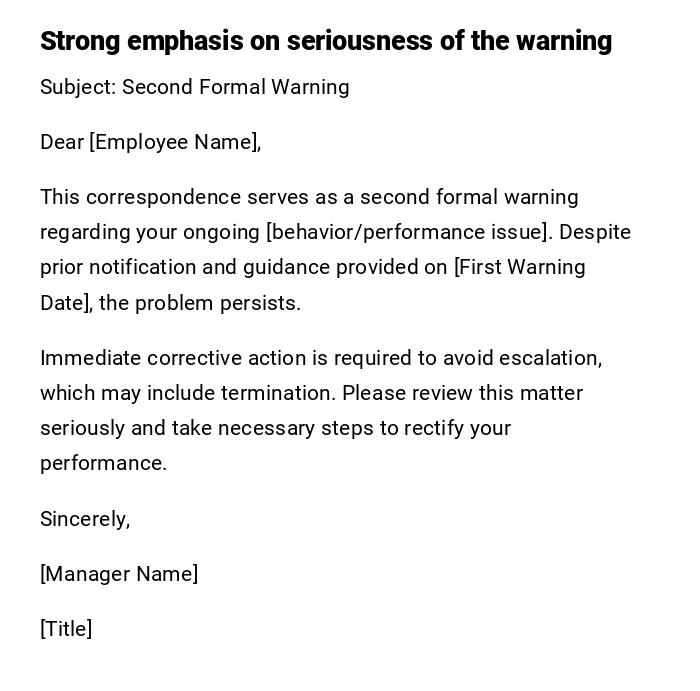
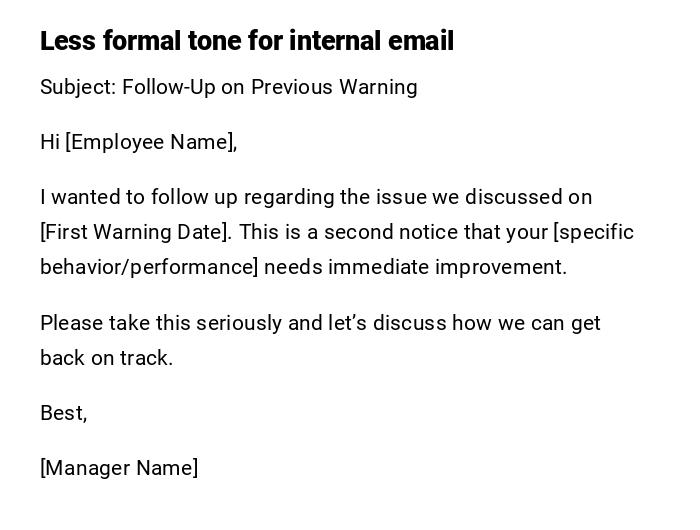
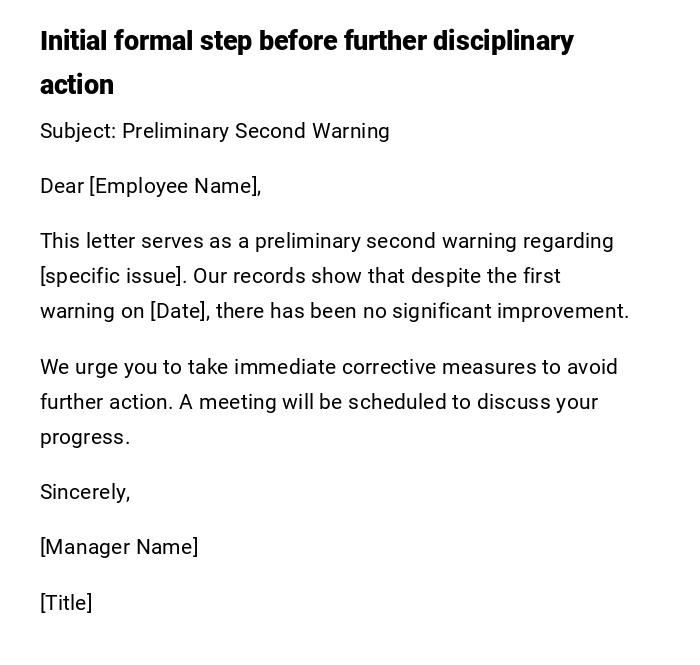
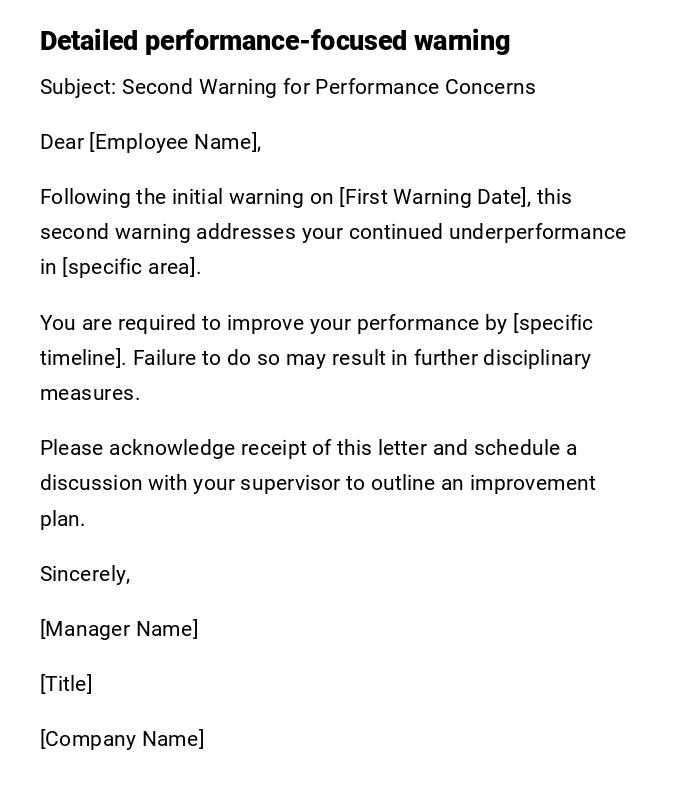
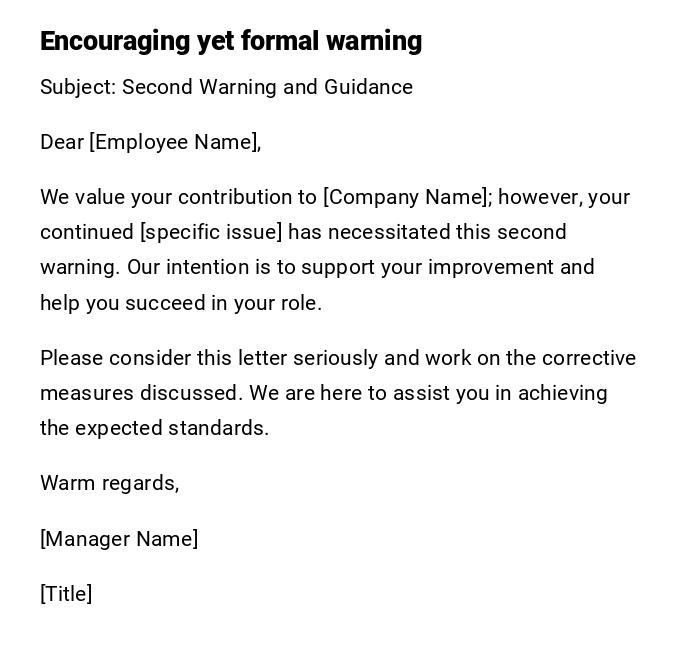
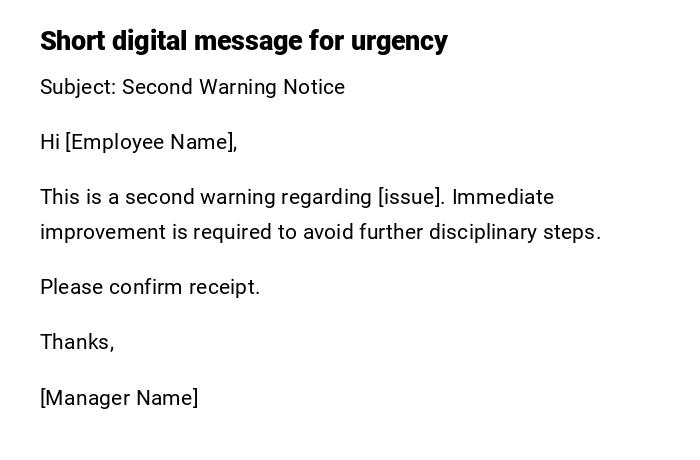

 Download Word Doc
Download Word Doc
 Download PDF
Download PDF